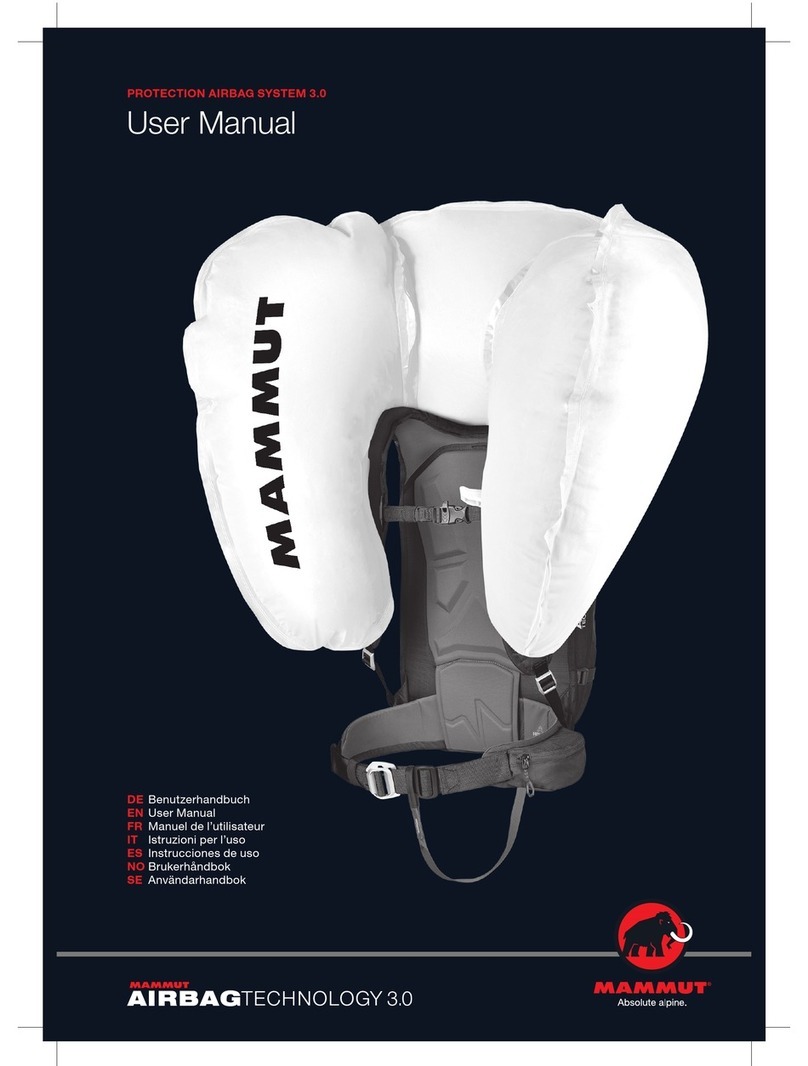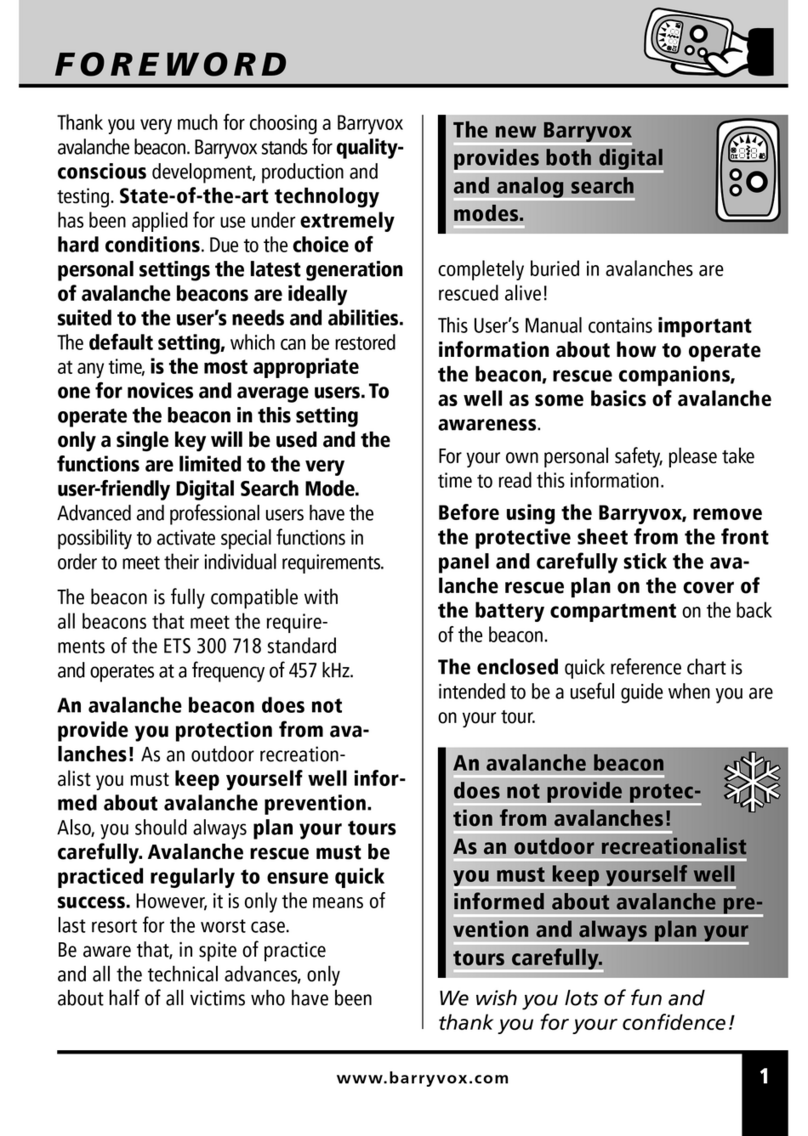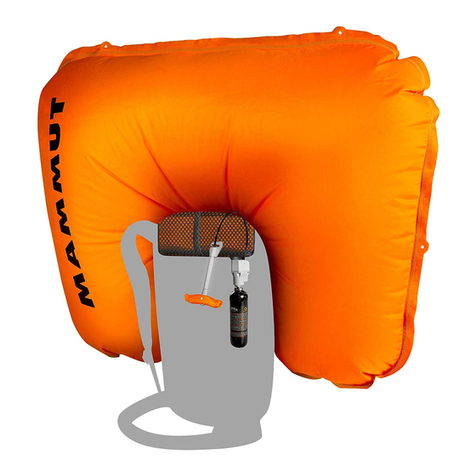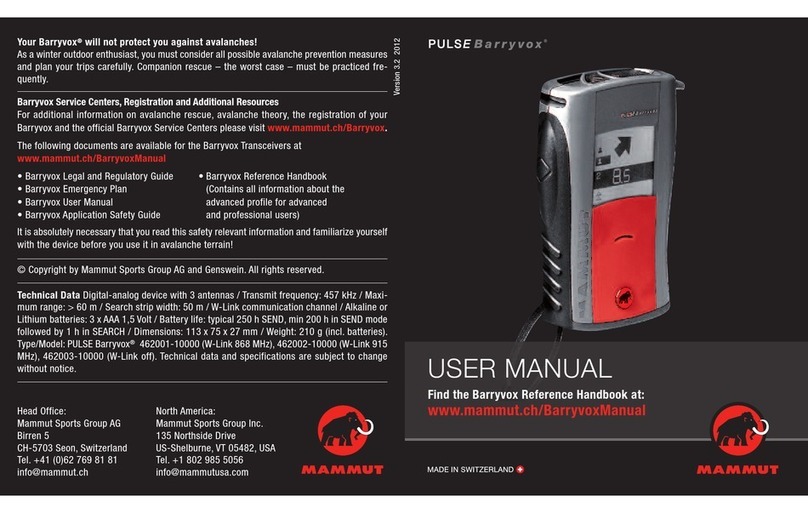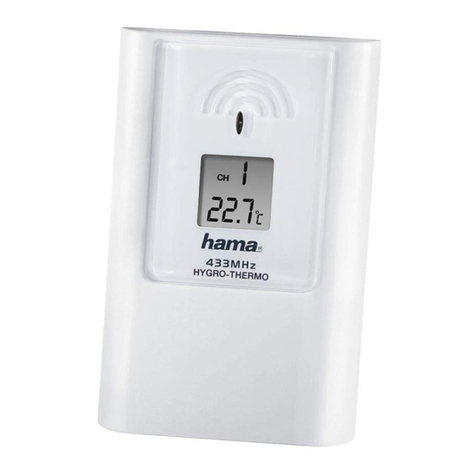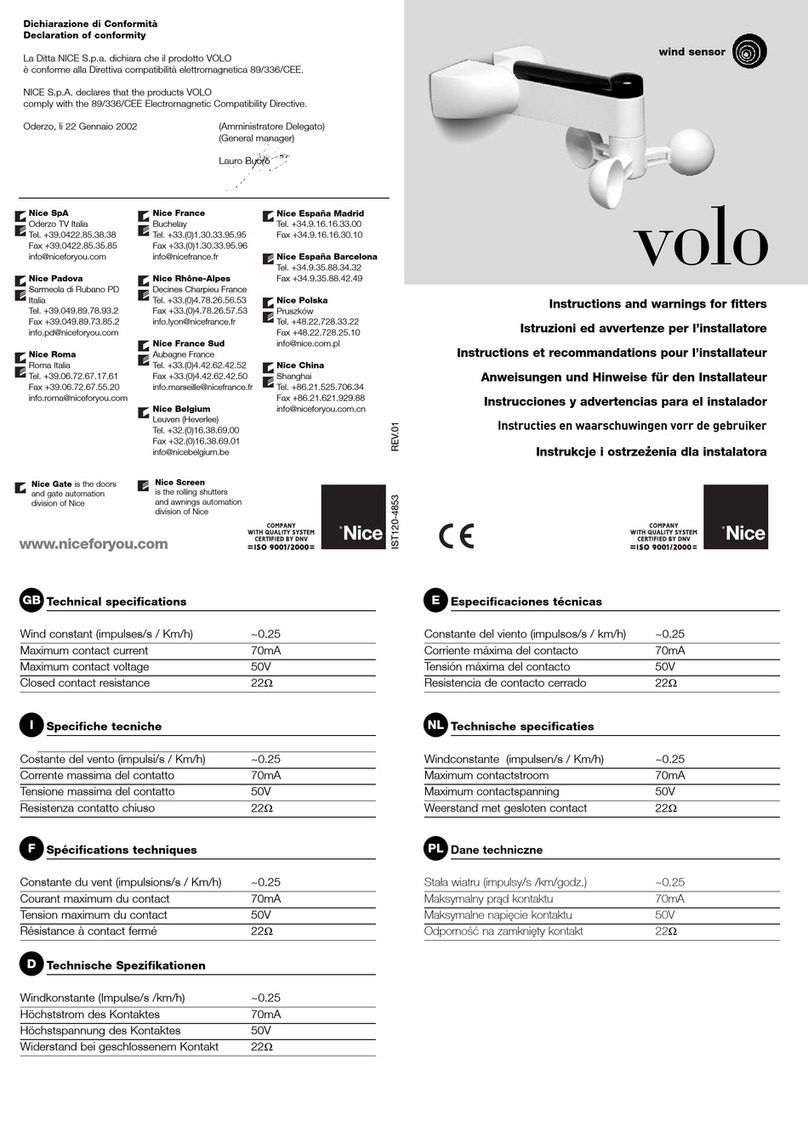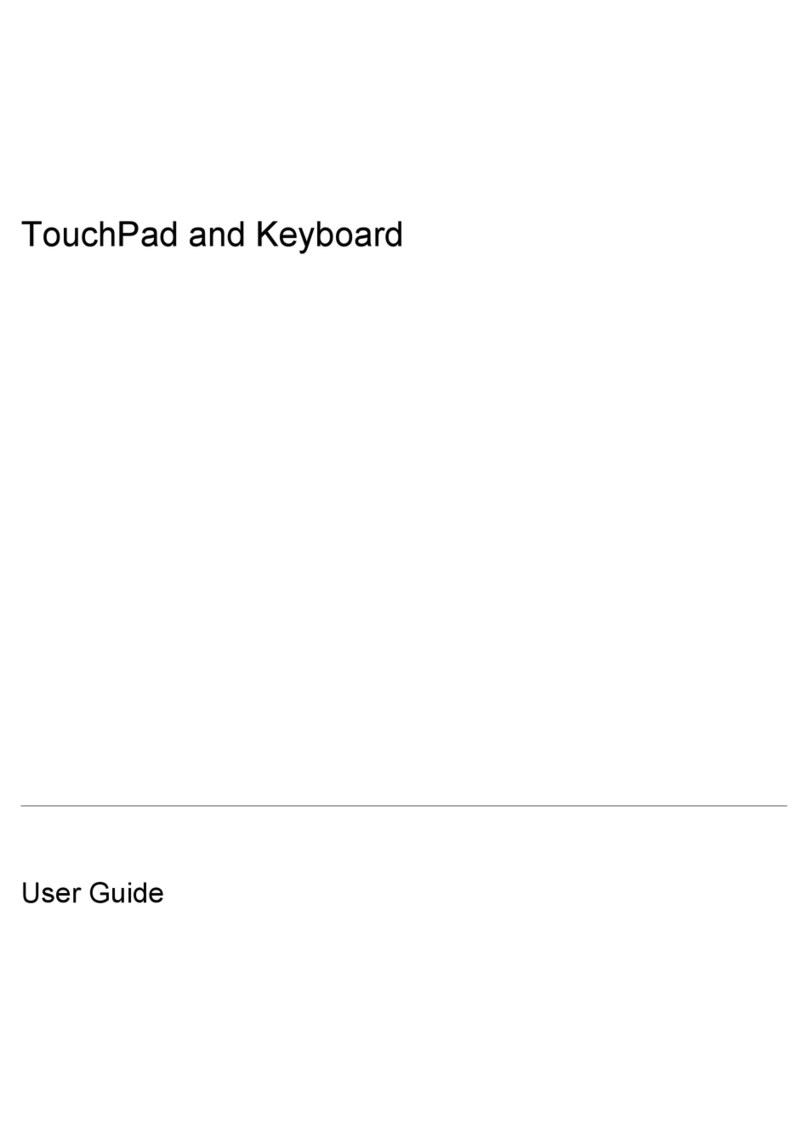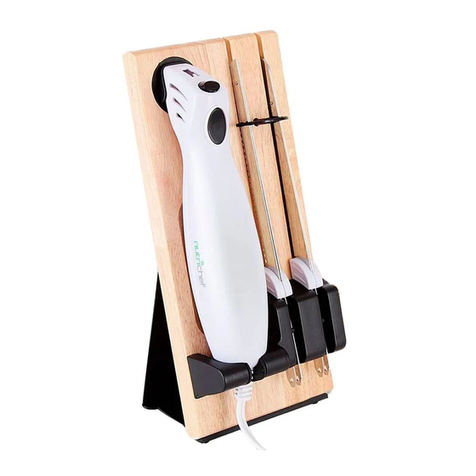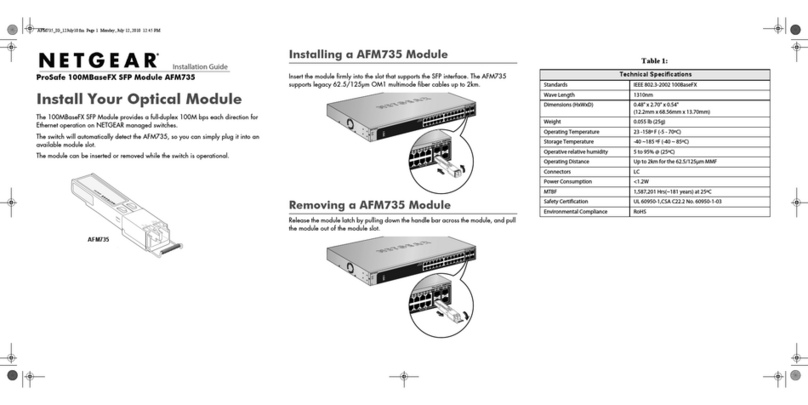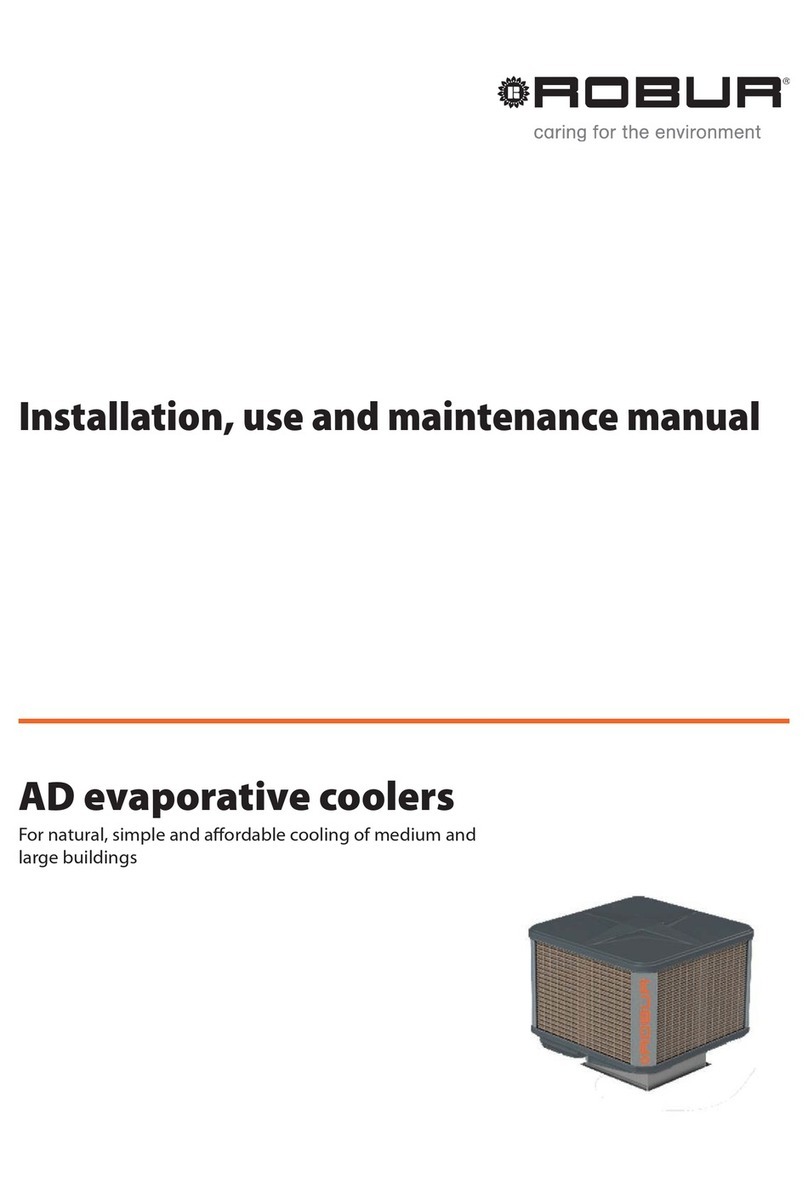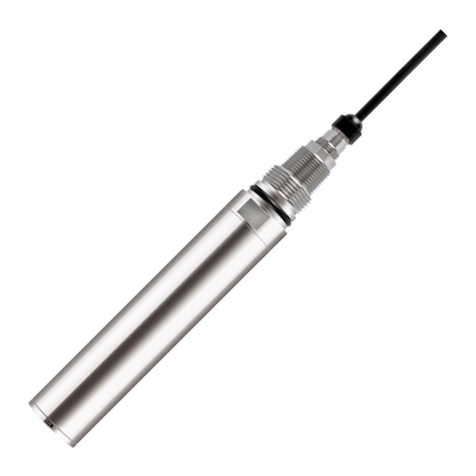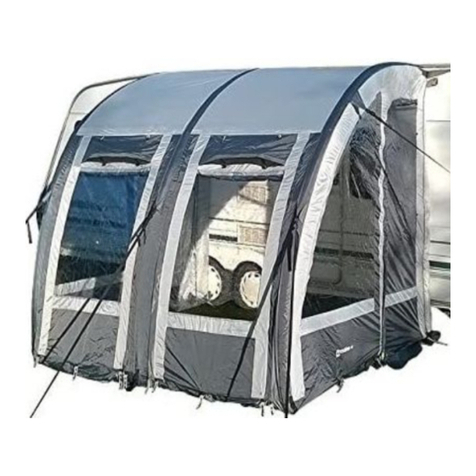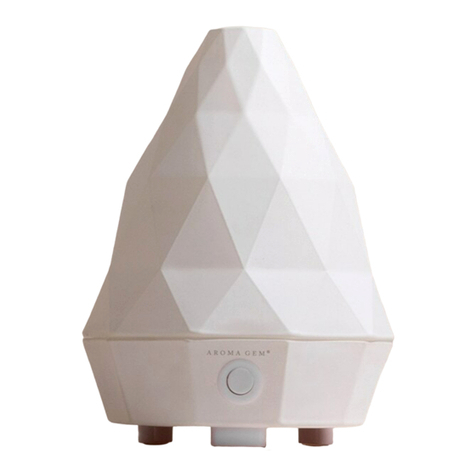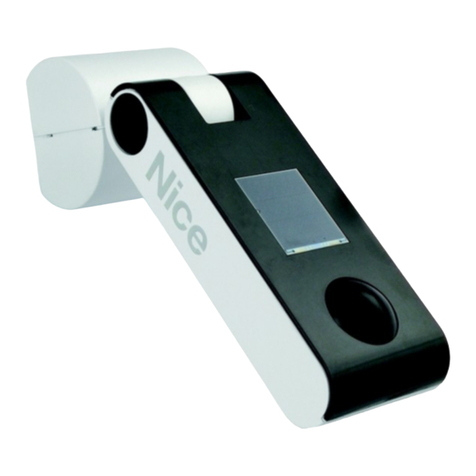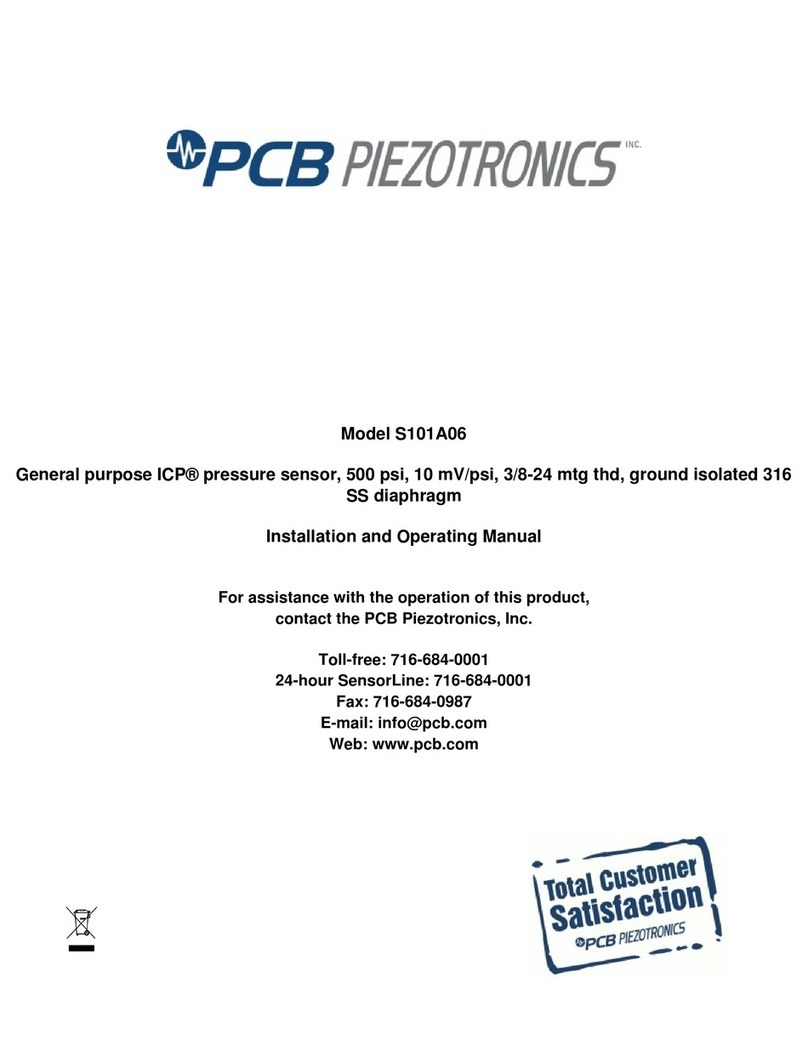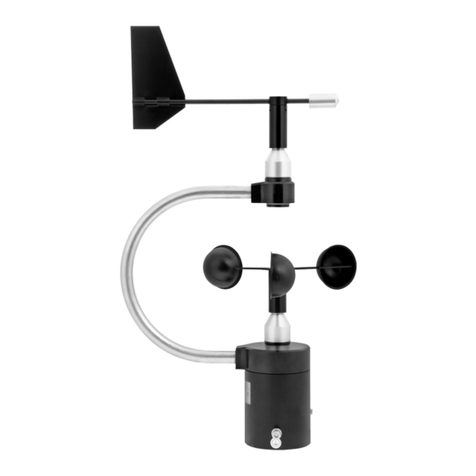Mammut Airbag Technology 3.0 User manual

REMOVABLE AIRBAG SYSTEM 3.0
User Manual
DE Benutzerhandbuch
EN User Manual
FR Manuel de l’utilisateur
IT Istruzioni per l’uso
ES Instrucciones de uso
NO Brukerhåndbok
SE Användarhandbok


D
E
1
Inhalt
1. Einleitung und Funktionsweise 2
2. Warnung 2
3. Funktionsweise 2
4. Lieferumfang 2
5. Anleitung 3
5.1 Airbag in Betrieb nehmen,
richtig anziehen und auslösen 3
5.2 Erneuter Gebrauch (Falten) 4
5.3 Airbag-System einbauen 5
5.4 Airbag-System ausbauen 6
5.5 Trainingsauslösung 6
5.6 Befestigung Material am Rucksack 6
6. Kartuschen 6
6.1 Allgemein 6
6.2 Typen und Wiederbefüllung 7
6.3 Hinweise 7
7. Fliegen mit Lawinenairbags 7
8. Kartuschen-Verleihstationen 7
9. Pflege, Wartung und weitere Informationen 7
9.1 Reinigung 7
9.2 Wartung und Entsorgung 7
9.3 Wartung nach einem Lawineneinsatz 7
9.4 Lagerung 8
9.5 Lebensdauer 8
9.6 Spezifikationen 8
9.7 Kennzeichnung am Produkt 8

D
E
2
Removable Airbag System 3.0
Anwendung und Technik. Jeder Benutzer übernimmt
sämtliche Risiken und akzeptiert die gesamte Verant-
wortung für alle Schäden und Verletzungen, welche
während der Benützung von Mammut-Artikeln vor-
kommen können. Hersteller und Fachhandel lehnen
jede Haftung im Falle von Missbrauch und unsach-
gemässem Einsatz und/oder Handhabung ab. Diese
Richtlinien sind hilfreich für die richtige Anwendung
des Produktes. Da jedoch nicht alle Falschanwendun-
gen und Fehlermöglichkeiten aufgeführt werden kön-
nen, ersetzen sie niemals eigenes Wissen, Schulung,
Erfahrung und Eigenverantwortung.
3. Funktionsweise
Der Lawinenairbag macht sich das physikalische Ge-
setz der inversen Segregation (Sortiereffekt) zunutze.
Dieser bewirkt, dass in einer sich gleichmässig bewe-
genden Masse von Teilchen (z. B. Schnee) die kleine-
ren Partikel nach unten rutschen, und die grösseren
Partikel oben aufschwimmen. Der Lawinenairbag ver-
grössert durch Ziehen des Auslösegriffs das Volumen
und verstärkt diesen Effekt erheblich. Damit kann der
Lawinenairbag aktiv einer Verschüttung bzw. Teilver-
schüttung vorbeugen und ermöglicht im Idealfall die
Selbstrettung oder eine schnelle Ortung.
4. Lieferumfang
01 Rucksack (falls Sie das Airbag-System einzeln
gekauft haben, müssen Sie den dazu passenden
Rucksack separat beziehen)
02 Airbag-System
03 Handbuch
1. Einleitung und Funktionsweise
Vielen Dank, dass Sie sich für den Kauf eines Mam-
mut Lawinenairbags entschieden haben. Lesen Sie
dieses Handbuch sorgfältig durch und beachten Sie
die Warnhinweise und Richtlinien.
Der Mammut Lawinenairbag erhöht bei einem Lawi-
nenabgang die Chance, an der Oberfläche der La-
wine zu bleiben. Der Lawinenairbag bietet allerdings
keine Überlebensgarantie, denn die Effektivität des
Lawinenairbags während des Lawinenabgangs hängt
stark von der Schneemenge, Schneedichte und ins-
besondere von der Geländebeschaffenheit ab. Gehen
Sie daher niemals ein erhöhtes Risiko ein. Eine Lawine
ist immer lebensbedrohlich, unabhängig von der ver-
wendeten Ausrüstung. Der Lawinenairbag sollte wie
Barryvox®, Sonde, Schaufel und Erste Hilfe-Set zur
Standardsicherheitsausrüstung für Skitourengeher
und Freerider gehören. Eine fundierte Risikomanage-
ment-Ausbildung und das Training mit dem Sicher-
heitsequipment ist darüber hinaus unabdingbar.
Avalanche
Airbag
Schaufel
Barryvox®
Handy
Sonde
Erste Hilfe-
Set
2. Warnung
Jede Person, die Mammut Material benutzt, ist per-
sönlich verantwortlich für das Erlernen der richtigen

D
E
Benutzerhandbuch
3
04 Trigger Test Tool (zum Ausführen einer Testaus-
lösung ohne Kartusche)
05 Druckkartusche (die für das System notwendige
Kartusche ist nicht im Lieferumfang enthalten und
muss separat bezogen werden)
i
01
03
05
04
02
5. Anleitung
5.1 Airbag in Betrieb nehmen, richtig anziehen
und auslösen
01 Überprüfen Sie, ob das Airbag-System korrekt ein-
gebaut wurde, bevor Sie sich in lawinengefährdete
Gebiete begeben. Folgen Sie dazu den Anweisun-
gen in Kapitel 5.3.
02 Überprüfen Sie vor jedem Einsatz, ob der Druck der
Kartusche stimmt.
AKartusche mit Manometer: Pfeil muss bei Raum-
temperatur von 20°C/68°F im grünen Bereich sein.
BKartusche ohne Manometer: Tatsächliches Ge-
wicht der Kartusche (ohne Schutzkappe) muss
dem Gewicht entsprechen, das auf der Kartusche
angegeben ist (+/–5g).
0
+/– 5g
02
A B
03 Kartusche bis zum Anschlag in den Mechanismus
schrauben, mit Klettverschluss in Kartuschenta-
sche befestigen und Tasche schliessen. Stellen
Sie sicher, dass keine Fremdkörper in der Tasche
sind. Die Verwendung des Mammut Airbags ist
ausschliesslich mit Mammut oder Snowpulse Kar-
tuschen gestattet.
ACHTUNG: Kartusche vollständig einschrauben
(schwarze Gummidichtung darf nicht sichtbar sein).
Kartusche muss mit Klettverschluss gesichert sein.
03
04 Stellen Sie die Höhe des Auslösegriffs im linken
Schulterträger ein. Es gibt drei verschiedene Ein-
stellungen (S/M/L). Im Idealfall ist der Griff auf
Brusthöhe. Der Haken sollte wie in der Abbildung
dargestellt vollständig eingehängt sein.
Schliessen Sie den oberen Reissverschlussschie-
ber bis knapp unter die Befestigung. Verwenden
Sie den unteren Reissverschlussschieber zum Ein-
und Auspacken des Griffs.
Sie können den Reissverschluss blockieren, indem
Sie den Schiebegriff nach oben klappen.
S
M
L
04
locked unlocked
05 Zum richtigen Anziehen des Lawinenairbags Bein-
gurt in Hüftgurt einhängen; Hüftgurt schliessen
(die Mitte des Hüftgurtes sollte in etwa mit dem
Hüftknochen abschliessen); Schulterträger fest-
ziehen; Brustgurt schliessen. Die Beinschlaufe
kann ebenfalls in der Länge verstellt werden. Bein-
schlaufe sollte eng sitzen.
06 Vor Betreten eines möglichen Lawinengebiets Aus-
lösegriff aus Tasche ziehen und in T-Form drehen.
Zum Verstauen des Auslösegriffs Knopf unterhalb

D
E
4Removable Airbag System 3.0
04 Reissverschluss Airbag-System-Tasche wieder
schliessen
05 Reissverschlussschieber der Airbag-Öffnung von
links nach rechts bringen
04 05
06 Airbag flach ausbreiten und falten nach Bebilde-
rung Sie finden eine Videoanleitung zum Falten auf
unserer Homepage
www.mammut.swiss/airbags
ACHTUNG: Der Airbag-Ballon darf zum Verpacken
nicht eingerollt werden.
06
des Griffs drücken und in vertikale Position drehen.
Griff in Schulterträgertasche stecken und Reissver-
schluss schliessen.
07 Sollten Sie in eine Lawine geraten sein, lösen Sie
den Airbag sofort aus. Lösen Sie lieber einmal zu
viel, als einmal zu wenig aus. Ziehen Sie dazu kraft-
voll und ruckartig am Auslösegriff.
Der Airbag wird sich in ca. drei Sekunden selbständig
füllen. Während dem Füllvorgang vernehmen Sie ein
signifikantes Füllgeräusch.
05
07
06
5.2 Erneuter Gebrauch (Falten)
Der Lawinenairbag kann nach einer Auslösung erneut
verwendet werden. Allerdings muss das Gerät nach
einem Einsatz in einer Lawine vom Mammut Kunden-
service überprüft werden. Nur so kann eine erneute
einwandfreie Auslösung garantiert werden. Wenden
Sie sich in diesem Fall an Ihren Mammut Händler.
Von einer Verwendung ohne vorheriger Kontrolle wird
dringend abgeraten.
Nach einer Trainingsauslösung können Sie Ihr System
aber auch selbst wieder bereit machen. So gehen Sie
vor:
01 Kartusche abschrauben und vom System trennen
02 Reissverschluss Airbag-System-Tasche öffnen
03 Anheben der Schutzkappe und «Deflation-Knopf»
drücken und Luft aus Airbag drücken (je weniger
Luft im Airbag ist, desto einfacher ist das anschlie-
ssende Falten)
02 03

D
E
Benutzerhandbuch
5
04 Airbag darf nicht verdreht herum eingehängt wer-
den.
04
DO NOT
TWIST
05 Auslösegriff und Airbag-System durch Öffnung in
Airbag-System-Tasche stecken
06 Airbag-System-Tasche schliessen
05 06
07 Auslösegriff darf nicht um Airbag-System gewi-
ckelt sein.
07
08 Auslösegriff in linken Schulterträger stecken
08
07 Falten abschliessen, Klettverschluss über Air-
bag-Öffnung schliessen um Airbag-Ballon zusam-
men zu halten
08 Reissverschluss der Airbag-Öffnung langsam
schliessen und anschliessend in Schlaufe einhän-
gen
ACHTUNG: Beim Schliessen darauf achten, den Air-
bag-Ballon nicht zu beschädigen.
07 08
09 Neue Kartusche verwenden oder Kartusche füllen
und Kartuschendruck überprüfen (siehe Kap. 5.1)
10 Kartusche einschrauben und in Kartuschentasche
befestigen (siehe Kap. 5.1)
5.3 Airbag-System einbauen
Das Removable Airbag-System 3.0 kann in verschie-
dene kompatible Rucksäcke eingebaut werden. Be-
achten Sie, dass Sie das Removable Airbag-System
3.0 nur in Removable Airbag-System 3.0-Rucksäcke
einbauen können.
01 Airbag-Ballon-Tasche öffnen (Reissverschluss von
der Mitte aus öffnen und Schieber auf rechte Seite
bringen)
02 Airbag flach ausbreiten. Lassen Sie wenn nötig alle
Luft aus dem Airbag (siehe Kap. 5.2).
03 Airbag-System sollte zum Einbau über grauem
Band (rot in der Abbildung) liegen.
03

D
E
6
Removable Airbag System 3.0
01
5.6 Befestigung Material am Rucksack
Unsere Rucksackmodelle bieten eine Vielzahl an
Möglichkeiten verschiedenste Materialien am Ruck-
sack zu befestigen. Folgende Punkte müssen speziell
beachtet werden:
01 Grundsätzlich muss darauf geachtet werden, bei
der Befestigung die Airbag Entfaltung durch das
zusätzliche Material nicht zu beeinträchtigen. Das
heisst: Die Öffnung des Airbags darf nicht blockiert
werden (z.B. Befestigung Seil am Rucksack).
02 Schaufel und Sonde können im Rucksack trans-
portiert werden. Je nach Rucksack hat es meist ein
separates Fach für die Sicherheitsausrüstung.
03 Der Eispickel kann ausserhalb des Rucksacks be-
festigt werden. Verwenden Sie dabei aber immer
eine Pickelschutzkappe wie die Mammut Ice Spike
Protection. Damit verhindern Sie, dass die Spitze
des Pickels im Ernstfall den Lawinen-Airbag-Bal-
lon beschädigt. Die Ice Spike Protection ist für die
gängigsten Hochtouren-Pickel geeignet.
04 Wir empfehlen die Ski immer diagonal am Ruck-
sack zu befestigen. Die A-Fixierung ist zwar mög-
lich aber nur im ungefährlichen Gebiet zu empfeh-
len. Bei der A-Fixierung kann das Aufblasen des
Airbags beeinträchtigt werden.
01
04
03
6 Kartuschen
6.1 Allgemein
Die Druckkartuschen sind der Energiespeicher des
Airbag-Systems. Es gibt verschiedene Kartuschen
in unserem Sortiment, die mit dem Removable Air-
09 Vier farbige Airbag-Schnallen in entsprechende
Schlaufen einhängen (von unten nach oben)
GREEN BLUE
YELLOW
RED
09
10 Airbag-Ballon falten und einpacken wie in Kap. 5.2
beschrieben
11 Auslösegriff wie in Kap. 5.1 beschrieben einhängen
5.4 Airbag-System ausbauen
Das Removable Airbag-System 3.0 kann in wenigen
Schritten aus dem Rucksack ausgebaut werden (sie-
he Bebilderung aus Kap. 5.3).
01 Kartusche abschrauben
02 Airbag-Ballon-Tasche öffnen
03 Airbag-System-Tasche öffnen
04 Vier Airbag-Ballon-Schnallen lösen
05 Auslösegriff in Schulterträger lösen und in Haupt-
fach führen
06 Auslösegriff und Airbag-System durch Loch in Air-
bag-System-Tasche führen
5.5 Trainingsauslösung
Das Training mit Ihrem Lawinenairbag ist notwendig,
um sich mit dem System vertraut zu machen und im
Ernstfall schnell und intuitiv handeln zu können. Trai-
nieren Sie besonders das Auslösen Ihres Lawinenair-
bags, damit Sie auch spüren, wie stark Sie am Auslö-
segriff ziehen müssen. Damit Sie Ihren Lawinenairbag
nach einem Training nicht ständig neu falten müs-
sen, können Sie auch eine Trockenauslösung ohne
Druckkartusche durchführen. Mit dem Trigger Test
Tool können Sie sehr einfach eine solche Trocken-
auslösung durchführen. Wir empfehlen Ihnen, min-
destens einmal zum Beginn einer Wintersaison eine
Trockenauslösung durchzuführen.
Verwendung Trigger Test Tool
01 Schrauben Sie das Trigger Test Tool in die Auslöse-
mechanik (bis zum Anschlag).
02 Ziehen Sie den Rucksack an (siehe Kap. 5.1). Wir
empfehlen Ihnen auch bei einer Trockenauslösung
Ihre Funktionsbekleidung zu tragen, um die Aus-
lösung so real wie möglich zu gestalten. Besonders
das Auslösen mit Ihren Handschuhen ist eine gute
Übung.
03 Lösen Sie Ihren Lawinenairbag aus wie in Ka p. 5.1
beschrieben.
04 Schrauben Sie anschliessend das Trigger Test Tool
von der Auslösemechanik.

D
E
Benutzerhandbuch
7
8. Kartuschen-Verleihstationen
Eine einfach Möglichkeit mit Ihrem Lawinenairbag zu
verreisen, bieten unsere zahlreichen Kartuschen-Ver-
leihstationen. Mieten Sie sich einfach Ihre Lawinenair-
bagkartusche vor Ort.
Hier finden Sie eine Übersicht aller Verleihstationen:
www.mammut.swiss/airbags-travel
9. Pflege, Wartung und weitere Informationen
9.1 Reinigung
Reinigen Sie den Mammut Lawinenairbag ausschliess-
lich mit Wasser. Verwenden Sie keine Lösungsmittel.
Nach der Reinigung muss der Airbag für einen erneuten
Gebrauch vollkommen trocken sein. Trocknen Sie den
Airbag an der Luft. Breiten Sie den Airbag dazu flach
aus. Vermeiden Sie zum Trocknen direkte Sonnenein-
strahlung, Wäschetrockner oder die Heizung.
9.2 Wartung und Entsorgung
Eine regelmässige Wartung Ihres Lawinenairbags
wird empfohlen.
Untersuchen Sie Ihre Ausrüstung vor und nach jedem
Einsatz auf Zeichen von Schäden und Abnutzung.
Folgende Punkte sind zu beachten:
01 Stellen Sie sicher, dass das Airbag-System richtig
eingebaut (Kap. 5.3) und gefaltet (Kap. 5.2) ist.
02 Stellen Sie sicher, dass Ihre Kartusche den richti-
gen Druck hat und vollständig eingeschraubt ist.
(schwarze Gummidichtung darf nicht sichtbar sein)
(Kap. 5.1).
03 Führen Sie einmal pro Saison eine Trainingsaus-
lösung durch. Die Trainingsauslösung kann auch
mit einer leeren Kartusche oder mit dem Trigger
Test Tool durchgeführt werden. Die Auslösung war
erfolgreich, wenn Sie ein deutliches «Klack»-Ge-
räusch hören (Kap 5.6).
04 Überprüfen Sie den Airbag-Ballon auf Löcher oder
Risse.
05 Sollte der Airbag übermässig nass geworden sein,
breiten Sie ihn flach aus und lassen ihn trocknen.
06 Überprüfen Sie das Airbag-System auf Schäden
(Risse im Gehäuse, Dellen, sichtbare Gewinde, etc.).
07 Untersuchen Sie Rucksack, Schulterträger und
Hüftgurt auf Löcher, Risse und beschädigte Nähte.
Wenn bei der Überprüfung Anzeichen von Schäden
festgestellt werden oder sonstige Zweifel an der Zu-
verlässigkeit bestehen, wenden Sie sich an den Kun-
denservice. Beschädigte Ausrüstung muss entweder
ordnungsgemäss entsorgt oder vor dem erneuten
Gebrauch durch unseren Kundenservice repariert
werden. Selbständige Reparaturen oder Änderungen
am Produkt, die nicht explizit in diesem Handbuch
aufgeführt werden, sind untersagt.
9.3 Wartung nach einem Lawineneinsatz
Jeder Lawineneinsatz kann den Lawinenairbag be-
schädigen, da dieser in der Lawine enormen Kräften
ausgesetzt ist. Daher ist die Wartung des Systems
nach einem Lawineneinsatz unerlässlich. Diese War-
tung muss vom Mammut Kundendienst durchgeführt
werden. Kontaktieren Sie Ihren Fachhändler oder den
Mammut Kundendienst, um eine Kontrolle oder War-
tung zu veranlassen.
bag-System 3.0 kompatibel sind. Alle Kartuschen, die
mit dem Inflation System 2.0 (ab 2011/2012) kompati-
bel waren, sind auch mit dem neuen Airbag System
3.0 kompatibel.
Mit einer Kartusche kann immer nur eine Auslösung
durchgeführt werden. Nach einer Auslösung muss die
leere Kartusche erneut befüllt werden.
6.2 Typen und Wiederbefüllung
Verwenden Sie nur Mammut oder Snowpulse Kartu-
schen mit Mammut Airbags:
Carbon-Kartusche
Die leichteste Kartusche in unserem Sortiment muss
nach einer Verwendung durch einen Mammut Händler
ausgetauscht werden. Viele Mammut Händler bieten
einen kostengünstigen Austausch gegen eine neue
Kartusche an. Nicht erhältlich in USA und Kanada.
Stahlkartusche
Die Stahlkartusche muss nach einer Verwendung
durch einen Mammut Händler ausgetauscht werden.
Viele Mammut Händler bieten einen kostengünstigen
Austausch gegen eine neue Kartusche an. Nicht er-
hältlich in USA und Kanada.
Aluminiumkartusche
Die Aluminiumkartusche wird hauptsächlich in den
USA und Kanada vertrieben. Die Kartusche kann
durch den Kunden selbständig wiederbefüllt wer-
den. Bitte beachten Sie unser Handbuch zum Selbst-
befüllen und die Liste offizieller Befüllstationen der
207-Bar-Aluminiumkartusche:
www.mammut.swiss/cartridge-refill
6.3 Hinweise
– Kartusche muss nach Verwendung ausgetauscht
oder wiederbefüllt werden. Anleitung zur Befüllung
siehe www.mammut.swiss/airbags
– Fülldruck muss vor jeder Benutzung überprüft werden
– Nur Mammut oder Snowpulse Kartuschen mit Mam-
mut Airbag verwenden
– Kartuschen dürfen nie zu grosser Hitze ausgesetzt
sein (direkte Sonneneinstrahlung/Ofen/etc.)
– Kartuschen nur innerhalb des erlaubten Tempara-
turbereichs verwenden (–30 bis +40°C)
– Kartuschen dürfen nicht beschädigt werden. Beschä-
digte Kartuschen müssen ausgetauscht werden
– Kartusche muss vollständig in Airbag System einge-
schraubt sein (Schwarze Gummidichtung darf nicht
sichtbar sein)
– Kartusche muss mit Klettverschluss im Rucksack ge-
sichert werden
7. Fliegen mit Lawinenairbags
Mammut Lawinenairbags können grundsätzlich per
Flugzeug transportiert werden (Achtung Sonderrege-
lung USA). Druckkartuschen für Lawinenairbags gel-
ten als Gefahrgüter. Daher gibt es für diese spezielle
Regelungen für die Mitnahme im Flugzeug.
Finden Sie immer die aktuellsten Informationen zum
Thema Fliegen mit Kartuschen hier:
www.mammut.swiss/airbags-travel

D
E
8
Removable Airbag System 3.0
Folgende Faktoren verkürzen die Lebensdauer ei-
nes Lawinenairbags: Einsätze in einer Lawine, harte
Stürze, Abrieb, Abnutzung, lange direkte Sonnenein-
strahlung, Salzwasser, salzhaltige Luft, Korrosions-
mittel. Der Einsatz eines Lawinenairbags im Verleih-
betrieb kann die Lebensdauer ebenfalls drastisch
verkürzen.
Sorgfältige und regelmässige Wartung kann die Le-
bensdauer des Lawinenairbags erhöhen (Kap. 9.2).
9.6 Spezifikationen
Typ: Removable Airbag-System 3.0
Zulässige
Betriebstemperatur: – 30°C bis 40°C
Betriebshöhe: 0 bis 6000 m.ü.M.
Airbagvolumen
aufgeblasen: 150 l
Systemgewicht
ohne Kartusche
ohne Rucksack: ca. 700 g
Füllvorgang: ca. 3 bis 5 Sekunden
Hersteller: Mammut Sports Group AG
Birren 5
CH-5703 Seon
CE: PPE – Guideline 89/686/EWG
(Cat. 2)
Standard: prEN 16716: 2015
9.4 Lagerung
Lagern Sie den Mammut Lawinenairbag an einem
kühlen, trockenen Ort.
Trennen Sie die Kartusche für eine längere Lagerung
vom System. Lagern Sie die Kartuschen ebenfalls an
einem kühlen trockenen Ort. Verwenden Sie zur Lage-
rung der Kartuschen den Kartuschendeckel und die
Originalverpackung.
9.5 Lebensdauer
Bei optimaler Lagerung und seltener Nutzung sollten
Sie Ihren Lawinenairbag spätestens nach 10 Jahren
(ab Herstellungsdatum) oder spätestens nach 40 Aus-
lösungen (mit oder ohne Kartusche) austauschen. Die
Lebensdauer kann im Voraus nicht genau berechnet
werden, denn sie wird von zahlreichen Faktoren wie
Gebrauchshäufigkeit, Behandlung, klimatischen Ein-
flüssen, etc. beeinflusst.
Anhaltspunkte für die Gebrauchsdauer liefert die fol-
gende Tabelle:
Verwendungshäufigkeit in
Einsatztagen pro Jahr bei
optimaler Lagerung
Ungefähre
Lebensdauer
Seltene Benutzung
Bis 10-mal pro Jahr bis 10 Jahre
Gelegentliche Benutzung
Zwischen 10- und 40-mal pro Jahr 5–7 Jahre
Häufige Benutzung
Zwischen 40- und 80-mal pro Jahr 3–5 Jahre
Ständige Benutzung
80-mal pro Jahr 1–3 Jahre
Batch No.
Serial No.
Standard
YYWW
xxxxxxxxx
prEN167116:2015
Batch No.
Serial No.
Standard
YYWW
xxxxxxxxx
prEN167116:2015
Batch No.
Serial No.
Standard
YYWW
xxxxxxxxx
prEN167116:2015
Batch No.
Serial No.
Standard
YYWW
xxxxxxxxx
prEN167116:2015
Highmark Ination System 3.0:
Mammut Ination System 3.0:
Markenlogo
Airbag-System Typ
Hinweis das Benutzerhandbuch zu lesen
Hersteller und Adresse Hinweis das Benutzerhandbuch zu lesen
geltender Standard für Lawinenairbagsysteme
Produktions-
chargennummer Jahr
und Kalenderwoche
der Herstellung
Einmalige
Seriennummer
Produktions-
chargennummer
Airbag-System-Typ
Mammut
Artikelnummer
CE Konfirmitätszeichen
9.7 Kennzeichnung am Produkt
01 Airbag-System
02 Rucksack
Paper lables for SMS Wi 1415 date: 18.09.2013
prepared: AFipage: 1 this design is protected by copyright © Mammut Sports Group
Style No.: xxxx-xxxxx
Batch# & Prod.Date: xxx-xxxx
Mammut Sports Group AG
Birren 5, CH-5703 Seon
Switzerland
Style No.: xxxx-xxxxx-xxxx-xxx
Batch No.: xxx-xxxx-xxxxx
Mammut Sports Group AG
Birren 5, CH-5703 Seon
Switzerland
RAS (Dong In)PAS, Highmark (Pungkook)
this design is protected by copyright © Mammut Sports Group
Style:
Date:
Season:
D&D: Producer:
Removable Airbag Woven Label
26.05.2015
Wi1617
AFi
Smoke
Pantone: 18-5105 TPX
Name:
Mam-Airbag-Removable
White
Pantone: 11-0601 TPX
Fire
Pantone: 18-1763 TPX
(bright red)
Nilorn

E
N
9
Content
1. Introduction and operation 10
2. Warning 10
3. Operation 10
4. Parts needed for operation 10
5. Instructions 11
5.1 Preparing, putting on and deploying
the airbag 11
5.2 Further use (folding) 12
5.3 Installing the airbag system 13
5.4 Removing the airbag system 13
5.5 Training deployment 14
5.6 Attaching equipment to the backpack 14
6. Cartridges 14
6.1 General information 14
6.2 Types and refilling 14
6.3 Further information 15
7. Flying with an avalanche airbag 15
8. Cartridge rental stations 15
9. Care, maintenance and further information 15
9.1 Cleaning 15
9.2 Maintenance and disposal 15
9.3 Maintenance after use in an avalanche 15
9.4 Storage 15
9.5 Durability 15
9.6 Specifications 16
9.7 Product labeling 16

E
N
10
Removable Airbag System 3.0
from the use of Mammut products. Neither the manu-
facturer nor the retailer accept any liability in the event
of misuse and improper use and/or handling. These
guidelines are intended to help you use the product
correctly. Since it is not possible to list all incorrect us-
ages and possible errors, these instructions can never
replace your own knowledge, training, experience and
personal responsibility.
3. Operation
The avalanche airbag uses the physical law of in-
verse segregation (sorting effect). This means that in
an equally moving mass of particles (e.g. snow), the
smaller particles gravitate to the bottom while the
larger ones rise to the surface. Pulling the deployment
handle increases the wearer’s volume, significantly
boosting this effect. Consequently, the avalanche air-
bag can actively help prevent burial or partial burial
and, in an ideal situation, allow self-rescue or rapid
location.
4. Parts needed for operation
01 Backpack (if you have bought the airbag system
by itself, you must obtain the matching backpack
separately)
02 Airbag System
03 Handbook
04 Trigger Test Tool (for test deployment without car-
tridge)
05 Pressure cartridge (the necessary system car-
tridge is not included and must be ordered sepa-
rately)
1. Introduction and operation
Thank you for purchasing a Mammut avalanche air-
bag. Please read this manual carefully and note the
warnings and guidelines.
If you are caught up in an avalanche, a Mammut av-
alanche airbag increases your chance of staying on
the surface. However, an avalanche airbag does not
provide any guarantee of survival, as its effective-
ness in the avalanche depends to a great extent on
the volume of snow, the density of the snow and, in
particular, the nature of the terrain. You should there-
fore never take the extra risk. An avalanche is always
life-threatening, regardless of the equipment used.
Like a Barryvox®, probe, shovel and first aid set, an av-
alanche airbag should be part of every ski tourer’s or
freerider’s standard safety equipment. Sound training
in risk management and familiarization with your safe-
ty equipment are also essential requirements.
Avalanche
Airbag
Shovel
Barryvox®
Mobile
phone
Probe
First aid kit
2. Warning
Anyone using Mammut equipment is personally re-
sponsible for learning the proper use and technique.
Every user assumes any risks and accepts responsi-
bility for any damages or injuries of any kind that result

E
N
User Manual
11
CAUTION: Screw the cartridge in completely (the
black rubber seal must not be visible). The cartridge
must be secured using velcro.
03
04 Adjust the height of the deployment handle on the
left shoulder strap. There are three different set-
tings (S/M/L). The grip should ideally be at chest
height. The strap should be properly attached to
the hook.
Close the upper zipper until it is just below the at-
tachment. Use the lower zipper to install and re-
move the handle.
You can lock the zipper by folding the handle up.
S
M
L
04
locked unlocked
05 To put on the avalanche airbag correctly, thread the
hip belt through the leg strap; close the hip belt (the
hip belt should sit approximately on the hip bone);
tighten the shoulder straps; tighten the chest strap.
The length of the leg loop can also be adjusted. The
leg loop should also fit tightly.
06 Before entering areas with an avalanche risk, re-
move the deployment handle from the pocket and
turn into a T position. To stow the deployment han-
dle, press the button under the grip and twist it into a
vertical position. Place the grip in the shoulder strap
and close the zipper.
07 If you become caught in an avalanche, deploy the
airbag immediately. It is better to use it once too of-
ten than once too little. Pull the deployment handle
hard and decisively.
The airbag will automatically fill in approx. three sec-
onds. You will hear a relatively loud noise as the airbag
fills.
i
01
03
05
04
02
5. Instructions
5.1 Preparing, putting on and deploying the airbag
01 Check that the airbag system has been installed
correctly before entering terrain with a potential av-
alanche risk. Follow the instructions in Section 5.3.
02 Always check the filling pressure of the cartridge
before use.
A Cartridge with pressure gauge: At a room tem-
perature of 20°C/68°F, the arrow must be in the
green area.
B Cartridge without pressure gauge: the actual
weight of the cartridge (without protective cap)
must correspond to the weight indicated on the
cartridge (+/–5 g).
0
+/– 5g
02
A B
03 Screw the cartridge all the way into the mechanism,
fasten in the cartridge pocket using velcro and
close the pocket. Make sure there are no foreign
objects in the pocket. Mammut airbags may only
be used with Mammut or Snowpulse cartridges.

E
N
12 Removable Airbag System 3.0
06 Spread the airbag out flat and fold it according to
the illustration (you will also find video instructions
on folding the airbag on our website)
www.mammut.swiss/airbags
CAUTION: The airbag should never be rolled up be-
fore packing.
06
07 Once you have finished folding, close the velcro
fastening over the airbag opening to hold the airbag
together
08 Slowly close the airbag opening zipper and attach
to the loop
CAUTION: Take care not to damage the airbag when
closing the zipper.
05
07
06
5.2 Further use (folding)
The avalanche airbag can be reused after deployment.
However, after deployment in an avalanche, it must be
checked by Mammut Customer Service. This is the
only way to guarantee smooth deployment. If you have
used your airbag in an avalanche, please contact your
Mammut retailer. We strongly advise against using
your airbag without having it checked first.
After a test deployment, however, you can prepare
your system again yourself using the following pro-
cedure:
01 Unscrew the cartridge and remove it from the sys-
tem
02 Open the airbag system pocket zipper
03 Remove the protective cap, press the deflation but-
ton and press the air out of the airbag (the less air is
in the airbag, the simpler it is to fold)
02 03
04 Close the airbag system pocket zipper
05 Move the airbag opening zippers from the left to
the right
04 05

E
N
User Manual
13
05 06
07 The cable must not be wound around the airbag
system.
07
08 Place the deployment handle into the left shoulder
strap
08
09 Thread the four colored airbag buckles through the
appropriate loops (from bottom to top)
GREEN BLUE
YELLOW
RED
09
10 Fold the airbag and pack it as described in Section
5.2
11 Attach the deployment handle as described in Sec-
tion 5.1
5.4 Removing the airbag system
The Removable Airbag System 3.0 can be removed
from the backpack in just a few steps (see illustration
in Section 5.3).
01 Unscrew the cartridge
02 Open the airbag pocket
03 Open the airbag system pocket
04 Loosen the four airbag buckles
05 Loosen the deployment handle in the shoulder
strap and feed it into the main compartment
07 08
09 Use a new cartridge or refill the cartridge and check
the cartridge pressure (see Section 5.1)
10 Screw in the cartridge and secure the cartridge
pocket (see Section 5.1)
5.3 Installing the airbag system
The Removable Airbag System 3.0 can be installed in
various compatible backpacks. Please note that the
Removable Airbag System 3.0 can only be installed in
Removable Airbag System 3.0 backpacks.
01 Open the airbag pocket (open the zipper from the
center to the right)
02 Spread the airbag out flat. Remove all the air from
the airbag, if necessary (see Section 5.2).
03 Before installation, the airbag system should lie
over the gray strap (red in the illustration).
03
04 Make sure the airbag has not been attached the
wrong way round.
04
DO NOT
TWIST
05 Thread the deployment handle and airbag system
through the hole in the airbag system pocket
06 Close the airbag system pocket

E
N
14
Removable Airbag System 3.0
01
04
03
6 Cartridges
6.1 General
The pressure cartridges are the airbag system’s ener-
gy storage system. We stock a number of cartridges
that are compatible with the Removable Airbag Sys-
tem 3.0. All cartridges that were compatible with the
Inflation System 2.0 (from 2011/2012) are compatible
with the new Airbag System 3.0.
One cartridge allows only one deployment. After de-
ployment the empty cartridge must be refilled.
6.2 Types and refilling
Only use Mammut or Snowpulse cartridge with Mam-
mut airbags:
Carbon cartridges
These are the lightest cartridges we stock and must
be replaced by a Mammut retailer after deployment.
Many Mammut retailers offer a good price for replac-
ing old cartridges with new ones. Not available in the
USA and Canada.
Steel cartridges
These cartridges are slightly heavier and must be re-
placed by a Mammut dealer after deployment. Many
Mammut retailers offer a good price for replacing old
cartridges with new ones. Not available in the USA
and Canada.
Aluminum cartridges
Aluminum cartridges are mainly used in the USA and
Canada. Customers can refill the cartridges them-
selves. Please read our handbook on refilling car-
tridges yourself and the list of official filling stations
for 207 bar aluminum cartridges:
www.mammut.swiss/cartridge-refill
06 Thread the deployment handle and airbag system
through the hole in the airbag system pocket
5.5 Training deployment
Training with your avalanche airbag is necessary in
order to become familiar with your system and to be
able to act quickly and intuitively in an emergency. In
particular, you should practice deploying your ava-
lanche airbag in order to realize how hard you need
to pull on the deployment handle. In order to avoid
refolding your avalanche airbag after every practice,
you can also perform a dry deployment without a
pressure cartridge. The Trigger Test Tool allows you
to perform such a dry deployment simply. We recom-
mend at least one dry deployment before the winter
season begins.
Using the trigger test tool:
01 Screw the Trigger Test Tool all the way into the de-
ployment mechanism.
02 Put the backpack on (see Section 5.1). In order to
make the deployment as realistic as possible, we
recommend wearing your skiing clothes during
the dry deployment. Deploying the airbag wearing
gloves is particularly good practice.
03 Deploy your avalanche airbag as described in Sec-
tion 5.1.
04 Unscrew the Trigger Test Tool from the deployment
mechanism.
01
5.6 Attaching equipment to the backpack
Our backpack models offer a number of options for at-
taching a variety of different equipment to your back-
pack. The following points should be considered::
01 It is important to ensure that any attachment of ad-
ditional equipment does not inhibit the deployment
of the airbag. In other words: do not block the airbag
openings (e.g. attaching a rope to the backpack).
02 Your shovel and probe can be placed in your back-
pack. Most backpacks have a separate compart-
ment for safety equipment
03 Your ice ax can be attached to the outside of your
backpack. Always use an protective ax cap, such
as the Mammut Ice Spike Protection. This prevents
the tip of the ax damaging the avalanche airbag in
an emergency. The Ice Spike Protection is suitable
for most popular mountain tour ice axes.
04 We recommend that you always attach your skis
diagonally across your backpack. Although fixing
your skis in a A-shape is possible, we only ad-
vise doing so in safe terrain. Fixing your skis in an
A-shape can impair the inflation of the airbag.

E
N
User Manual
15
05 If the airbag is wet, spread it out flat and leave it
to dry.
06 Check the airbag system for damage (cracks in the
housing, dents, threading, etc.).
07 Check your backpack, shoulder straps and hip belt
for holes, tears and damaged seams.
If you discover signs of damage or have other doubts
about reliability, please contact Customer Service.
Damaged equipment must either be properly dis-
posed of or repaired by our customer services before
use. It is forbidden to make any repairs and changes to
the product, which are not explicitly described in this
manual, by yourself.
9.3 Maintenance after use in an avalanche
Any use in an avalanche can damage the avalanche
airbag because it is subject to enormous forces.
Maintenance of the system after use in an avalanche
is therefore essential. This maintenance must be per-
formed by Mammut Customer Service. Please con-
tact your retailer of Mammut Customer Service to
check or maintain your airbag.
9.4 Storage
Store your Mammut airbag in a cool, dry place.
Remove the cartridge if you intend to store the airbag
for a long time. Store your cartridges in a cool, dry
place. Use the cartridge cover and original packaging
to store cartridges.
9.5 Durability
Given optimum storage and rare use the product
should be replaced after a maximum of 10 years (from
date of manufacture) or after a maximum of 40 deploy-
ments (with or without cartridge). The product’s ser-
vice life depends on many factors, such as how often it
is used, where it is used, climatic influences, etc.
The following table provides guidelines concerning
the durability:
Frequency of use in days of
use per year (given optimum
storage)
Approximate
lifetime
Rare use
Up to 10 times per year Up to 10 years
Occasional use
Between 10 and 40 times per year 5–7 years
Regular use
Between 40 and 80 times per year 3–5 years
Constant use
80 times per year 1–3 years
The following factors affect the service life of an ava-
lanche airbag: use in an avalanche, heavy falls, abra-
sion, wear, long periods of direct sunlight, salt water,
salt air, corrosive substances. Renting an avalanche
airbag can also drastically reduce its durability.
Careful and regular maintenance can increase the
service life of an avalanche airbag (Section 9.2).
6.3 Further information
– Cartridges must be refilled or replaced after use.
Filling instructions: www.mammut.swiss/airbags
– The filling pressure must always be checked before
use
– Only use Mammut or Snowpulse cartridge with
Mammut airbags
– Cartridges must never be exposed to excessive heat
(direct sunlight, oven, etc.)
– Cartridges may only be used within the permitted
temperature range (–30 to +40°C)
– Cartridges must not be damaged. Damaged cartridg-
es must be replaced
– The cartridge must be screwed all the way into the air-
bag system (the black rubber seal must not be visible)
– The cartridge must be secured in the backpack using
velcro
7. Flying with an avalanche airbag
In general, it is possible to transport Mammut ava-
lanche airbags by air (please note there is a special
regulation for the USA). The pressure cartridges used
in avalanche airbags are classed as hazardous goods.
Special regulations therefore apply if you wish to carry
them with you on a flight.
You can always find up-to-date information on the
subject of flying with cartridges here:
www.mammut.swiss/airbags-travel
8. Cartridge rental stations
Our numerous cartridge rental stations offer a simple
way to travel with your avalanche airbag. Simply rent
your avalanche airbag cartridge locally.
A list of cartridge rental stations can be found here:
www.mammut.swiss/airbags-travel
9. Care, maintenance and further information
9.1 Cleaning
Only clean your Mammut avalanche airbag with water.
Do not use solvents. After cleaning, the airbag must
be completely dry before reuse. Dry the airbag in the
open air. Spread the airbag out flat. Do not dry in direct
sunlight or using a dryer or heater.
9.2 Maintenance and disposal
We recommend regular maintenance of your ava-
lanche airbag.
Check your equipment for signs of damage and wear
before every use.
The following points should be noted:
01 Ensure that the airbag system is correctly installed
(Section 5.3) and folded (Section 5.2).
02 Make sure that your cartridge has the correct pres-
sure and is completely screwed in. (The black rub-
ber seal must not be visible) (Section 5.1).
03 Perform at least one training deployment per
season. The training deployment can also be per-
formed with an empty cartridge or the Trigger Test
Tool. If the deployment is successful, you will hear
a clear “click” (Section 5.6).
04 Check the airbag for holes or tears.

E
N
16
Removable Airbag System 3.0
9.6 Specifications
Type: Removable Airbag System 3.0
Operating
temperature: – 30°C to 40°C
Operating altitude: 0 to 6000 m above sea level.
Airbag volume
(inflated): 150 l
System without
cartridge and
without backpack: approx. 700 g
Filling process: approx. 3 to 5 seconds
Manufacturer: Mammut Sports Group AG
Birren 5
CH-5703 Seon, Switzerland
CE: PPE – Guideline 89/686/EWG
(Cat. 2)
Standard: prEN 16716: 2015
9.7 Product labeling
01 Airbag system
02 Backpack
Batch No.
Serial No.
Standard
YYWW
xxxxxxxxx
prEN167116:2015
Batch No.
Serial No.
Standard
YYWW
xxxxxxxxx
prEN167116:2015
Batch No.
Serial No.
Standard
YYWW
xxxxxxxxx
prEN167116:2015
Batch No.
Serial No.
Standard
YYWW
xxxxxxxxx
prEN167116:2015
Highmark Ination System 3.0:
Mammut Ination System 3.0:
Brand logo
Airbag system type
Note to read user handbook Applicable standard for avalanche airbag systems
Production batch
number(year and
calendar week of
production)
Unique serial number
Manufacturer and
address
CE compliance label
Manufacturer and address Note to read user handbook
Production batch
number
Airbag system type
Mammut
item number
Paper lables for SMS Wi 1415 date: 18.09.2013
prepared: AFipage: 1 this design is protected by copyright © Mammut Sports Group
Style No.: xxxx-xxxxx
Batch# & Prod.Date: xxx-xxxx
Mammut Sports Group AG
Birren 5, CH-5703 Seon
Switzerland
Style No.: xxxx-xxxxx-xxxx-xxx
Batch No.: xxx-xxxx-xxxxx
Mammut Sports Group AG
Birren 5, CH-5703 Seon
Switzerland
RAS (Dong In)PAS, Highmark (Pungkook)
this design is protected by copyright © Mammut Sports Group
Style:
Date:
Season:
D&D: Producer:
Removable Airbag Woven Label
26.05.2015
Wi1617
AFi
Smoke
Pantone: 18-5105 TPX
Name:
Mam-Airbag-Removable
White
Pantone: 11-0601 TPX
Fire
Pantone: 18-1763 TPX
(bright red)
Nilorn

F
R
17
Sommaire
1. Introduction et fonctionnement 18
2. Avertissement 18
3. Fonctionnement 18
4. Éléments 18
5. Instructions 19
5.1 Mise en service, mise en place correcte
et déclenchement de l’airbag 19
5.2 Réutilisation (repliage) 20
5.3 Montage de l’Airbag System 21
5.4 Démontage de l’Airbag System 22
5.5 Entraînement au déclenchement 22
5.6 Fixation de matériel au sac à dos 22
6. Cartouches 22
6.1 Généralités 22
6.2 Types de cartouches et remplissage 23
6.3 Consignes 23
7. Prendre l’avion avec un
airbag d’avalanche 23
8. Points de location de cartouches 23
9. Entretien, maintenance et autres
informations 23
9.1 Nettoyage 23
9.2 Maintenance et élimination 23
9.3 Maintenance après une utilisation
en avalanche 23
9.4 Entreposage 23
9.5 Durée de vie 24
9.6 Caractéristiques techniques 24
9.7 Marquage du produit 24

F
R
18
Removable Airbag System 3.0
1. Introduction et fonctionnement
Vous avez fait l’acquisition d’un airbag d’avalanche
Mammut et nous vous en remercions. Lisez attenti-
vement le présent manuel et respectez les avertisse-
ments et les consignes qui y sont énoncés.
En cas de départ d’avalanche, l’airbag d’avalanche
Mammut augmente les chances de rester à la sur-
face. Cependant, l’airbag d’avalanche n’offre aucune
garantie de survie, son efficacité pendant l’avalanche
dépendant fortement de la quantité de neige, de sa
densité et en particulier de la configuration du lieu.
Par conséquent, ne vous exposez jamais à un risque
élevé. Une avalanche constitue toujours un danger de
mort, quel que soit l’équipement utilisé. Tout comme
le Barryvox®, la sonde, la pelle et la trousse de pre-
miers secours, l’airbag d’avalanche fait partie de
l’équipement de sécurité de base pour le ski de ran-
donnée et le freeride. Une solide formation à la gestion
des risques et l’entraînement à l’utilisation de l’équipe-
ment de sécurité sont en outre indispensables.
Airbag
d’ava-
lanche
Pelle
Barryvox®
Téléphone
portable
Sonde
Trousse de
premiers
secours
2. Avertissement
Toute personne utilisant du matériel Mammut est
personnellement tenue d’en apprendre la technique
d’utilisation correcte. Chaque utilisateur accepte tous
les risques et endosse l’entière responsabilité quant
aux éventuels dommages et blessures lors de l’utili-
sation d’articles Mammut. Le fabricant et les reven-
deurs déclinent toute responsabilité en cas de mau-
vais usage, d’utilisation impropre ou de manipulation
incorrecte. Les présentes consignes sont utiles pour
une utilisation conforme du produit. Toutefois, comme
il est impossible d’établir une liste exhaustive des cas
d’utilisation impropre et des possibilités d’erreur, rien
ne remplacera les connaissances personnelles, les
formations, l’expérience acquise et la responsabilité
individuelle.
3. Fonctionnement
Le fonctionnement de l’airbag d’avalanche repose sur
le principe de la ségrégation inverse (effet de disso-
ciation) : dans une masse se déplaçant de manière
uniforme (par ex. de la neige), les plus petites parti-
cules ont tendance à glisser vers le bas, tandis que les
plus grosses remontent à la surface. En actionnant la
poignée de déclenchement, l’airbag d’avalanche ac-
croît le volume afin d’amplifier cet effet. L’airbag d’ava-
lanche offre ainsi un moyen de prévention actif contre
l’ensevelissement, partiel ou total, et permet, dans
l’idéal, un autosauvetage ou une localisation rapide.
4. Éléments
01 Sac à dos (si vous avez acheté l’Airbag System
seul, vous devez vous procurer le sac à dos corres-
pondant séparément)
02 Airbag System
03 Manuel
04 Outil de test de déclenchement (Trigger Test Tool,
pour réaliser un essai de déclenchement sans car-
touche)
Other manuals for Airbag Technology 3.0
2
Table of contents
Languages:
Other Mammut Accessories manuals
